CRO: The Most Impactful Marketing Activity You’re Not Doing
Or at least not scientifically enough.
Does this story sound familiar?
You hired a marketing company to run ads or even started running an advertising campaign yourself on Google AdWords or Facebook Ads Manager. Your website is getting more traffic but your sales are only increasing marginally. You increase the budget to get more clicks but the result is the same.
What good is paying for more traffic if it doesn’t result in a large increase in sales or leads? If the visitors you were already getting would become customers instead, then you wouldn’t need to pay for extra traffic. What if we could increase sales, decrease the cost per lead, and increase profits without having to pay for more traffic?
We can with CRO.
What is CRO?
CRO stands for Conversion Rate Optimization. A conversion can be defined for our purposes as a website visitor taking a desired action (ideally revenue generating) such as filling out a form or making a purchase. Conversion rate is the % of visitors who take the desired action. Optimization is the action of making the best or most effective use of a situation or resource; in this case the conversion rate of the website. Thus, CRO is the practice of increasing your conversion rate or, even more accurately, increasing the percentage of website visitors that become leads/customers.
Why is CRO so Powerful?
There are some direct and indirect reasons that practicing CRO has such a powerful impact on a business.
More Money
Let’s start with the obvious, by increasing your conversion rate from let’s say 1% to 2% you are now doubling your leads/sales revenue. Congratulations!
No really, let that sink in.
By converting the website visitors you already get at 2x the current rate you now have 2x your current revenue/sales. Your profit has also increased, but this time at a rate even higher than 2x. Your fixed costs remain fixed so now you’re profiting a larger percentage of your overall revenue than before. Score!
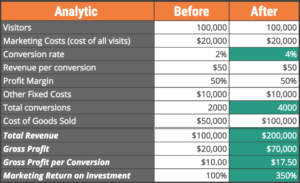
I even made this handy calculator you can use to see how your company’s bottom line will be impacted by conversion rate increases:
Lower Advertising Costs
Focusing on CRO efforts actually decreases your variable costs as well, specifically your digital paid advertising costs on networks like Google AdWords, Facebook, and Bing. In Google AdWords, there is a measurement called “Quality Score” which grades your landing page performance and ad against the search query on a scale from 1-10. The higher your quality score the less you have to pay for each click. Google incentivizes advertisers in this way because they want to remain the best search network for users, and delivering high-quality results ensures their stronghold on the search market. Performing CRO successfully and improving the performance of your webpage will result in a higher quality score and a lower cost per click than before. The same type of principle applies to Facebook, Bing, and other digital advertising platforms.
To summarize: by increasing conversion rate you can pay less money for the same number of visitors (and those visitors will more frequently take the actions you want).
More Traffic
We just talked about how Google (and Bing and Yahoo) want to deliver great search results to their users so they can be the search engine of choice. This applies to organic search as well and today’s top Search Engine Optimization Specialists know that user experience (i.e. design, load time) and engagement metrics (i.e. dwell time, pogo-stick rate, deep clicks, etc.) are a major component of the SEO landscape. By executing a proper CRO strategy you will be improving your website’s reputation with search engines by achieving better engagement stats and improving the overall user experience. With all other factors remaining equal (there are, of course, a lot of SEO variables) your now higher converting website will begin to climb up the rankings and gain more search visibility, leading to increased website traffic.
It All Ties Together
So, conversion rate optimization can lead to a positive feedback loop where increased conversion rate leads to more conversions without needing more traffic. This then leads to more revenue and even greater profits. It also cuts down on advertising costs and eventually results in higher organic traffic (which will still convert at that higher rate).
You can then further refine your webpage and test for continued CRO improvement to start the positive feedback loop all over again. Wash, rinse, and repeat!
CRO Ideas to Get Started:
There are a lot of techniques that can be used in a CRO effort. We’ll focus first on a few easy, low hanging fruit that you can implement and test right away.
Button/Call-To-Action Colors
Simply changing the color of your button or CTA (call to action) can result in a fairly significant increase in conversion rate. Study after study shows that selecting a contrasting color to the rest of the website works best. For example, this blog post has a primarily teal background color but the CTA at the bottom of this post is orange, which is the exact opposite on the color wheel. This makes the button really stand out more, and believe it or not it makes a measurable difference in conversion performance (it’s a Jedi power –you will click the bright orange button).
Button/CTA Language
One day long long ago, after being inspired by a coworker (and generally being a psychology fanatic), I decided to change the default language on the website forms for my clients’ websites from “Submit” to “Send.” The idea was that the word “submit” might be unappealing to people and conjure up negative feelings or connotations at the subconscious level whereas “send” is at worst more neutral and at best more empowering. It may seem like an insignificant change prompted from extreme over-analysis and overemphasis on the details (yes), but this is CRO after all and everything can be tested and analyzed. Well, a few months later the data was clear and there was an almost universal increase in conversion rate across all forms in which this change was made. That’s just one example of how the right language can impact the performance of a button or CTA (the logic can also be applied to all of the content on a given page or site).
Here’s another case study:
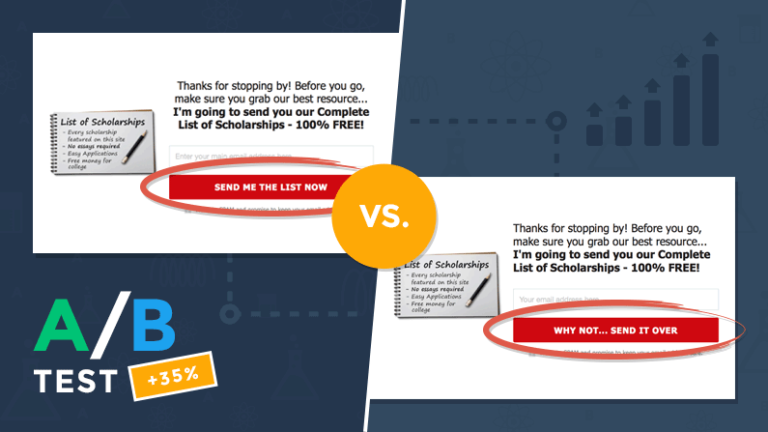
Social Proof/Trust Signals
Having things like customer reviews, testimonials (especially endorsements from trusted sources like celebrities and influencers), embedded tweets, quotes from media sources, or logos of trusted brands you’ve worked with, can all increase the likelihood of a conversion. These signals increase your credibility and authority as well as build trust with site visitors.
Guarantees & Added Value
Do you guarantee your product or service for a time period? Do you offer free shipping? A free consultation? These should be clearly visible to your website visitors and will encourage them to take action by eliminating friction and making it more of a “no-brainer.” If you do not have such an offer, consider creating one.
Remove Barriers
Speaking of eliminating friction for your users – another thing to consider when optimizing for conversions is to reduce or remove extra steps or added barriers as much as possible. Your form should be as simple as it can be. Don’t make someone register for your website to take a converting action. Make sure your website is compatible with all devices (mobile friendly). Always be thinking about making it as painless as possible for the visitor to do what you want.
More Advanced CRO Techniques:
Know Your Personas
If there is one rule to follow, this is it. By identifying and creating profiles of your target personas and then deeply understanding them, you can enhance all of your marketing activities and CRO tactics to increase the chances of a conversion. Knowing the needs, wants, pain points, tendencies, personalities, etc. of your customer is the heart of any effective marketing endeavor, and CRO is no different.
Knowing these personas also comes down to understanding why some users convert and why others don’t, and you can actually ask them using survey tools. You’d be surprised how often your current clients are willing to tell you why they bought from you as well as how often visitors will tell you in a simple pop-out survey why they do not plan to convert.
Conversion Options
What if the user is on your site but they hate email/digital checkouts and prefer a good old-fashioned phone call? You better have your phone number easy to access and clickable from a mobile device. You can also try adding options such as live chat, text and instant messaging, or even printable mail order sheets depending on your business. Get creative (and know thy customer)!
Design/Development
There can be an entire blog post dedicated to this area. One technique that can increase your conversion rate is to simply make your website faster as there is a strong correlation between load time and conversion rate.
Amazon found that for every 100ms of load time delay they lost 1% in sales revenue. That’s 10% for every second. That’s potentially billions of dollars on the line because of how fast their pages can load.
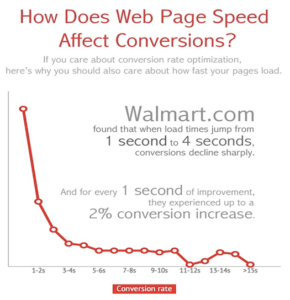
The design of a website can also impact conversion rate. As we discussed above, something as simple as the color or verbiage on a button can impact whether it’s clicked or not. There is an entire field of study called UX Design (User Experience Design) that looks at how design can guide desired behavior (among many other things). Find a designer who has experience creating websites to encourage the conversions that will support your business goals and who also understands the persona process, wireframing, prototyping, A/B testing, using tools to analyze current user behavior, and more.
Or save time and talk to us because we know all this stuff (shameless plugs are my latest CRO test).
Copywriting
Here is another area which can impact conversion rate that could fill an entire book, but I don’t have a book I have a blog post. Good copywriting will consider how an offer is worded or presented in order to maximize conversion potential. Consider this case study below:
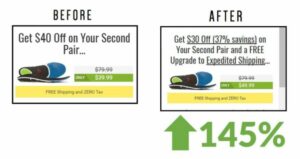
What else constitutes good copywriting? In most situations, highlighting the benefits of your product or service outperforms highlighting the features. Apple was famous for advertising “1000 songs [in your pocket]” when it introduced the iPod instead of saying “500 MB of Storage.” That’s an example of highlighting the benefit instead of the feature.
Telling a story is also a compelling copywriting technique. Whenever possible use a story that the reader can relate to, envision, or empathize with as stories are more powerful and memorable than simply describing your product or service. Storytelling is deeply ingrained in the human psyche and science supports this idea of using stories to help sell or add value to your offering.
Somewhat related to that; using 2nd person language is also a great method for using copy to sell. In 2nd person writing or speech you will do as I am doing in this sentence and use language such as “you” so that you get the reader to imagine themselves in the scenario. Let’s use the iPod example again:
“1000 songs in YOUR pocket.”
This is more effective than saying “My product will hold 1000 songs” (first person) or “Apple’s iPod can hold 1000 songs” (third person).
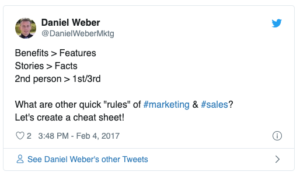
Use your copy as a chance to address any potential rebuttals. Study your customers and non-customers to find out why they buy or why they do not buy. By surveying customers you can also examine whether or not you’re comprehensively highlighting benefits in a convincing manner. Customers may help you discover new benefits you had not even intended/considered that you can now highlight moving forward.
You may find that customers think the price is too high. This means you need to build more perceived value into the page or perhaps you need to compare your product/service to a more expensive but less effective alternative. In a service business (like Site-Seeker) the alternative might mean the customer doesn’t utilize your expertise and they lose out on potential revenue, or they fail at the first attempt and lose more money overall. Present that story.
Finally, use concrete emotional statements over abstract or intellectual ones.
This is just a sampling of considerations in good copywriting to increase conversions. It’s very impactful when done well.
Here are some good brands to learn from:
Media Types
Try using video, audio, and images to enhance the page and engage your visitors more. Oftentimes when it comes to e-commerce stores the more images the better and a product video is even more powerful. That leads us to the next point…
Product Data
Tell them everything they could possibly need to know about the product. Leaving no stone unturned is not going to overload people so that they do not convert (in a well-designed page). Instead, it will prevent those people who might not convert because of a left-off detail (perhaps they need to know the dimensions or the materials used) from leaving without taking an action. As we mentioned above, don’t let there be unanswered objections in the user’s buying decision.
Your Actual Offer
Finally, CRO can be impacted by the details of the offer itself. Do you provide any money-back guarantees? Can you provide any added value products or services (i.e. free shipping)? Do you offer a free consultation? Consider what you can do to add value to the user then use the tactics above to best present it.
Your Reputation
That’s right, you might need to look big picture. Maybe the user will be more likely to convert if you have a better brand, better product/service, or are more likable. If you feel like you’ve done everything you can to your website to maximize conversions perhaps it is time to work on acquiring reviews, increasing the goodwill towards your brand, partnering with influencers, or other reputation management techniques.
Wrapping Up
I think we’ve made a sufficient case for CRO and given you some things to think about in terms of successfully implementing it on your own website. There are a number of other considerations and techniques in this field but we’ve presented some great places to start!
If you’d like to receive free individualized CRO ideas for your own website please email me using the form below and I’ll offer some suggestions.
If you’d like to get started on a CRO-focused campaign:
